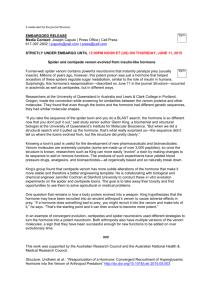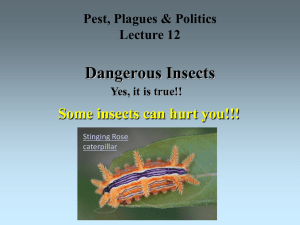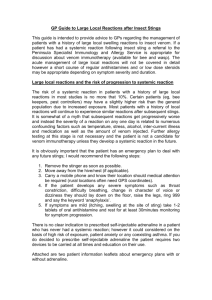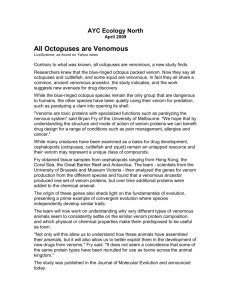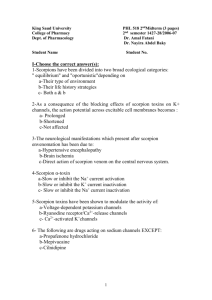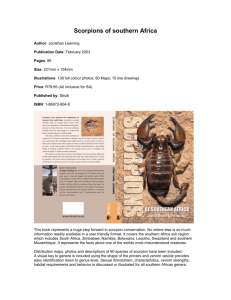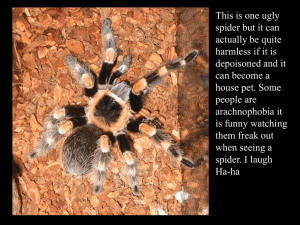Tarantulas & Their Venomous Cousins_FINAL
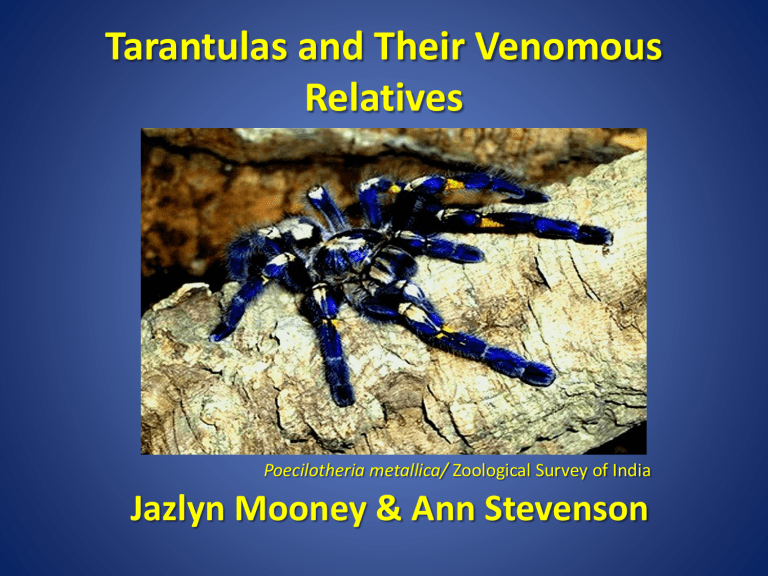
Tarantulas and Their Venomous
Relatives
Poecilotheria metallica/ Zoological Survey of India
Jazlyn Mooney & Ann Stevenson
Introduction
• We chose to study tarantula venom due to its broad spectrum of potential pharmaceutical uses.
• During our research we noticed that many large venomous spiders are commonly mistaken as tarantulas, thus creating an unnatural fear of tarantulas within the human population.
Introduction
• What is venom?
• True Tarantulas
- The difference between Old World & New
World
- Potential uses and mechanism
- Case Studies
• Venom of Spiders Commonly Mistaken as
Tarantulas
- Potential uses and mechanisms
Introduction
• Envenomation
• Antivenin
• Newly Discovered Species
• Summary
• Conclusion
What is venom?
Poisonous fluid secreted by animals and insects by typically injected into prey or aggressors by biting or stinging.
TRUE TARANTULAS
Categorization
New
World
Tarantulas
Old World
Tarantulas
True Tarantulas are categorized as either New World or Old
World based solely on their geographic location.
Briesemeister Projection
Out with the Old in with the New
• New World Tarantulas appear to have a mild temperament, thus seemingly they are more “tolerable” of humans. It is thought that the behavior may be due to an extra defense. Theses spiders have the ability to flick urticating hairs off of their bodies, while Old World
Tarantulas can only envenomate presumed predators
(tarantulaguyuk, 2011).
– Urticating hairs of a tarantula will cause varying levels of discomfort which include: burning, stinging, and itchiness. During molting periods tarantulas may incorporate these hairs on the webs as an additional deterrent to potential predators
(tarantulaguyuk, 2011).
Grammostola spatulata http://aboutmonca.blog.cz/galerie/sklipkani/obrazek/6023307
Grammostola spatulata
• Geographic Location: Northern Chile and Argentina
(animal-world.com)
– G. spatulata is the brown variety of the Chilean Rose Hair
– New World Tarantula
• Lifespan of females is about 20 years and males live about 6 years (animal-world.com)
• Typically very docile so they are commonly sold as low maintenance pets
• Venom is nontoxic for humans (Dobson 2001)
GsMTx4
• Isolated from G. spatulata with a specificity for particular mechanosensitive ion channels
(MSC). MSCs are ubiquitious non-specific tissues.
• Target: Stretch activated MSCs
• Potential Treatment: for cardiac arrhythmia, muscular dystrophy and glioma
GsMTx4 Mechanism
• The peptide binds to boundary lipids surrounding the channel and alters the voltage gated channel (Gottlieb et al. 2004)
– Boundary lipids are bent toward the channel
• Appears to be selective for Stretch Activated
Channels (Escoubas and Lachlan 2004)
GsMTx4 Mechanism
GsMTx4 alters the plasma membrane by bending the areas around the stretch activated voltage gated channels.
www.Beechhold,
Henry
Poecilotheria regalis http://www.mmo-champion.com
Poecilotheria regalis
• pronounced pee-suh-luh-THI-ree-uh (Beechhold, 2000)
• P. regalis is known as the Indian Ornamental
– New World tarantula
• It is primarily arboreal (bighairyspiders.com)
• There haven’t been a lot of studies done on the venom of P. regalis
– We decided to look up a couple of cases involving P. regalis envenomation to see if we could come up with any ideas about the potential type of venom it carries.
P. regalis venom
• Case 1
– "If you recall I mentioned that I was bitten by a 4 inch regalis last week and reported no particular problems other than a sore finger, of which the discomfort is slowly disappearing. I have now noticed one or 4 other things. Now whether they are related to this bite I simply don't know, only those who have been bitten before maybe able to comment. 2 nights ago approximately 24 hours after the bite my right calf muscle seized for approx. 5 minutes. I put this down to a simple muscle cramp. (Had them before but not for a few years). At approx. 6am in the morning I had another in the same leg. Now this got me thinking if it was related to the T bite.
That day I seemed very tired, exhausted and wanted to sleep, but I plodded on. The next day, still tired I finished work at 12pm dozed on the sofa and at around 3pm I got the same cramp, only this time in my left calf, later that day a muscle in my lower jaw temporarily seized during a yawn.” (www.bighairyspiders.com)
P. regalis venom
• Case 2
– “In 2000, a middle-aged man was bitten on his finger by an
Indian Ornamental Tarantula (Poecilotheria regalis
Poecilotheriinae) whose body was 4 cm long. He developed local swelling and erythema of the hand, and severe local pain. At follow up, 8 days later, these symptoms had resolved but he still had a tight feeling and cramps in the bitten hand and vague generalized ‘flu-like’ myalgias (muscle pain). “ (Ahmed et al.
2009)
• Case 3
– A man bitten by Poecilotheria regalis “experienced violent pain that radiated up the bitten arm into the axillary lymph nodes and persisted for 20 min.” (Ahmed et al. 2009)
P. regalis venom
• Case 4
– Personal Blog with video here is the link if you want to check it out: http://www.arachnoboards.com/ab/showthread.php?140875Poecilotheriaregalis&s=2ebd7a5f14e
6425f0d51a377fef376b1
“10:45pm - Initial bite:
Felt like a hot penny nail going through the skin. The actual bite felt hot - no little prick of pain, just heat. I immediately took 4 Benedryl [sic]. My hand turned red in a matter of seconds and I could actually feel the 'heat' going up my arm.
11:20pm:
Sweating profusely, cramps going all the way up my arm to my shoulder. Pain very bad!
12:20am:
Jaw started to hurt as well - other cramping continued. Pain about an 8 on a scale of 1-10. Left to go to the ER to have my vitals checked. Heart rate was up but otherwise I was fine, except for the cramping and pain. I was also nauseous by this point. Due to a 4 hour wait at the ER, I left at this point.
12:40am:
Joints in my arms and legs started hurting really bad…shortness of breath continued. Benedryl
[sic] really kicking in now - very tired and dizzy. Walking was difficult due to being so dizzy, tired, and having severe cramping.” (arachnoboards.com)
Venom Hypothesis
We believe that this venom is likely a neurotoxin based on the localized pain and the muscle cramps experienced by victims in all four cases.
There were additional cases of envenomation that we read about, and muscle cramps continue to be one of the major symptoms. Muscle cramps may indicate that the venom has some effect on potassium channels.
VENOMOUS SPIDERS COMMONLY
MISTAKEN FOR TARANTULAS
Phoneutria nigriventer courtesy of João P. Burini courtesy of João P. Burini
Phoneutria nigriventer
• “Phoneutria” translates to Murderess in Greek (Brazilian
Wandering Spider)
• Found throughout South America and Costa Rica (Brazilian
Wandering Spider)
• Commonly known as the Brazilian Wandering Spider or
Banana Spider
– This spider often hides in bunches of bananas during the day
• Can deliver potentially fatal doses of venom to humans
– LD
50
= 200 µg/kg (Ori and Ikeda 1998)
PnTx2-6 Neurotoxin
•
Isolated from P. nigriventer
•
Target: calcium channels
•
Potential Treatment: erectile dysfunction
(ED) (Nunes, 2010)
PnTx2-6 Mechanism for ED
•
Pntx2-6 indirectly induces activity in calcium channels which increases the level of nitric oxide (NO).
•
NO boosts circulation in the penis by helping the walls of the blood vessels to relax in cavernosal of rats (Nunes, 2010).
•
PnTx3-6
–
PnTx3-6 was isolated from P. nigriventer potential safer alternative to morphine (addictive opiate) and zinconotide which causes headache, nausea, confusion, vomiting, etc. (De Souza 2011).
• Target: Ca 2+ ion gated channels
•
–
Potential treatment for allodynic, long-term, and pre or postoperative pain
Authors observed no neurological, cardiac, or immunological side effects in any rats or mice. The withdrawal symptoms were also less severe when using
PnTx3-6 (De Souza 2011).
PnTx3-6 Mechanism
• Molecular binding site is still unknown (Vieira et al. 2005)
• Completely or incompletly blocks the external pore of the calcium channels
• Complete blockage of N-type calcium channel suggests that the toxin binds tightly to the external mouth of the channel and physically occludes the pore (Vieira et al. 2005).
Macrothele raveni
Macrothele raveni
•
Commonly known as the Chinese Funnel
Web
•
The body length of this hairy spider is only 2-3cm (Zeng, et al 2003)
•
The LD
50
= 0.772 mg/kg of raventoxin-I in mice (Zeng, et al 2003)
Macrothele raveni
• Venom isolated from M. raveni selectively suppresses the growth of cancerous cells via apoptosis
• Target: caspase 3 and caspase 8 pathways
• Potential Treatment: myelogenous leukemia
(Liu et al., 2012)
M. raveni venom
• Venom activates caspase 3 an apoptosisrelated peptidase that interacts with caspase
8.
– Caspase 3 plays a central role in the executionphase of cell apoptosis via the extrinsic signaling pathway. (Clark and Tyler,
2009)
Clarke and Tyler, 2009
M. raveni venom
• In the extrinsic pathway, death ligands bind and activate their cognate receptors (Fas). (Clarke and Tyler, 2009)
• The toxin induces apoptosis in myelogenous leukemia
K562 cell line without affecting other cells (Liu et al., 2012)
Clarke and Tyler, 2009
Atrax robustus http://www.arachnoboards.com/
Tirin/Ianmacm
Atrax robustus
• A. robustus is a venomous funnel web spider centrally located in Sydney, Australia
• One of the only spider species with confirmed deaths
-Most appear to be caused by males
(inchem.org)
• The Sydney Funnel Web Spider injects venom every time it strikes
This venom is known as Robustoxin
(inchem.org)
LD
50
= 0.16 mg/kg (Sheumack et al. 1984) http://www.micropest.com/
Robustoxin
• Robustoxin affects the cardiovascular system, central nervous system and peripheral nervous system
– Robustoxin alone causes a typical syndrome of envenomation in primates and man of whole male
Atrax robustus venom. (Sheumack et al. 1984)
– On the autonomic system the venom causes both inhibition of neurally mediated release of transmitters
(eg noradrenaline, acetylcholine) and an increase in spontaneous transmitter release. A similar action on the skeletal muscle neuromuscular junction has been postulated (inchem.org)
Envenomation
Envenomation
• The bite causes intense pain and redness
• Symptoms of envenomation can be seen within the first ten minutes.
– Symptoms include: muscle spasms, salivation or lachrymation, piloerection (goose bumps), tachycardia, shortness of breath, disorientation, and confusion (inchem.org)
– Hypertension, hypotension, pulmonary edema, and raised intracranial pressure can also occur in severe envenomation (inchem.org)
Venom Optimization Hypothesis
The “venom optimization hypothesis” postulates that due to the high metabolic costs of venom regeneration, venom dosage is behaviorally controlled and used as economically as possible.
(Morgenstern & King,
2012)
Morgenstern and King, 2012
Antivenin
http://www.venompatrol.org
Focus
We focused specifically on antivenin for the Sydney Funnel Web Spider (A.
robustus), because it has the most confirmed fatalities out of all venomous spiders. Antivenin isolated from the Sydney
Funnel Web Spider has also been used to treat envenomation from another genera of funnel web known as Hadronyche.
Background
• This map gives the location of two genera of the Australian
Funnel Web Spiders (Atrax and
Hadronyche).
• An antivenin from A. robustus known as FWS AV went into use beginning in 1980 (Graudins, et al. 2002).
• Physicians began to treat bites from Hadronyche genera with
FWS AV and noticed that symptoms of envenomation were alleviated in their patients (Graudins, et al. 2002).
The Research
Researchers confirmed that FWS AV can be used to treat envenomation from both A. robustus and several species of Hadronyche spiders (H. versuta,
H. infensa, H. cerberea, and H. Formidabilis).
Antivenin Conclusion
• The ability to use the same antivenin across multiple species of animals is known as polyvalence.
• The polyvalence of FWS AV is likely due to venom homologies across these two genera of
Funnel Web Spiders.
– Researchers believe it may be linked to atracotoxins, which are shared by both genera.
(Graudins et al., 2002.)
Newly Discovered Species
Poecilotheria rajaei
Ranil Nanayakkara / British Tarantula Society
Poecilotheria rajaei
• pronounced pee-suh-luh-THI-ree-uh (Beechhold, 2000)
• Discovered and identified April 2013 in Sri Lanka
• Size of the human face
• Usually found in trees, however with habitat shrinking found in old abandoned buildings (Drake, 2013)
• Not toxic to humans (Drake, 2013)
Summary
• Tarantulas and their close relatives both produce venom that affect many systems of the body. Their venom seems to be highly specialized, and targets only particular ion channels.
• Venom is constructed of numerous compounds whose functions and consequences vary based on environment.
Conclusion
• We realize that although we had a unnatural fear for tarantulas and their sister taxa in the beginning , we now respect them for the potential medical benefits they can provide for us.
– Maybe that’s worth the creepiness of these wonderful arachnids?
• Tarantula venom has novel compounds that come with both positive and negative consequences.
Learning about these compounds may help to develop new pharmaceuticals and new antivenins for spider bites.
References
• Ahmed, N., et al. 2009. “Symptom in search of a toxin: muscle spasms following bites by Old World tarantula spiders (Lampropelma nigerrimum,Pterinochilus
murinus, Poecilotheria regalis) with review” Oxford University Press. Vol. 102 pp 851–857.
• Beechhold, Henry F. "A Key to the Pronunciation and Meaning of Scientific Names of Popular Species Part I: Pronunciation." A Key to the Pronunciation and
Meaning of Scientific Names of Popular Species Part I: Pronunciation.” The
American Tarantula Society, 2000. Web. 16 Apr. 2013.
<http://atshq.org/articles/beechwp1.html>.
• "Brazilian Wandering Spider." Brazilian Wandering Spider. Turkcebilgi, 2010.
Web. 15 Apr. 2013. <http://english.turkcebilgi.com/Brazilian wandering spider>.
• Clarke, P. and Tyler, K.L. 2009. “Apoptosis in animal models of virusinduced disease” Nature Review Microbiology. Vol. 7 pp. 144-155
• C., Rob. "P. Regalis Bite Report Thread: Poecilotheria Regalis." Web Blog post.
Arachnoboards RSS. vBulletin, Nov. 2007. Web. 17 Apr. 2013.
<http://www.arachnoboards.com/ab/showthread.php?140875
Poecilotheria-regalis>.
References
• De Souza, A.H., et al., 2011. “Antiallodynic effect and side effects of Phα1β, a neurotoxin from the spider Phoneutria nigriventer: Comparison with conotoxin MVIIA and morphine.” Toxicon Vol. 58 pp 626-633.
• Dobson, Roger, 2001. “Spider venom may prevent atrial fibrillation”
Western Journal of Medicine Vol. 3 pp 164.
• Drake, N., 2013 "New Giant Tarantula Discovered in Sri Lanka |
Wired.com." Wired Science. 2 Apr. 2013. Web. Date accessed
5 Apr. 2013.
• Escoubas, Pierre, and Lachlan, Rash. 2004. "Tarantulas: eight-legged pharmacists and combinatorial chemists." Toxicon Vol. 43 pp. 555 –
574.
• Gottlieb, Philip A. et al. 2004. “Mechanosensitive Ion Channels as Drug
Targets” CNS & Neurological Disorders Vol. 3, pp 61-72.
• Graudins, A., et al., 2002. “Cross-reactivity of Sydney funnel-web spider antivenom: neutralization of the in vitro toxicity of other
Australian funnel-web (Atrax and Hadronyche) spider venoms”
Toxicon Vol. 40 pp 259–266.
References
• Gurley, Russ, and Brough, Clarice. "Rose-haired Tarantula." Animal World.
Animal World, 2012. Web. 15 Apr. 2013. <http://animalworld.com/encyclo/reptiles/spiders/rosehairtarantula.php>.
• Liu, Z., et al., 2012. “The venom of the spider Macrothele raveni induces apoptosis in the myelogenous leukemia K562 cell line.”
Leukemia Research. Vol. 36, No. 8, pp 1063-1066.
• Nunes, K.P, et al. 2010, “Nitric Oxide-Induced Vasorelaxation in
Response to PnTx2-6 Toxin from Phoneutria nigriventer Spider in Rat Cavernosal Tissue” The Journal of Sexual Medicine
Volume 7 Issue 12 pp 3879-3888.
• Ori, Masahisa and Ikeda, Hiroyoshi, 1998. "Spider Venoms and Spider
Toxins". Jounal of Toxicology.Toxin reviews 17 (3): 405-426.
• Sheumack DD, Baldo BA, Carroll PR, Hampson F, Howden ME,
Skorulis A, 1984. "A comparative study of properties and toxic constituents of funnel web spider (Atrax) venoms". Comparative
biochemistry and physiology Vol. 78 pp. 55-68.
References
• Schumm, Thomas. "Tarantula Bites!" Web log post. Phong's
Tarantulas! N.p., 2013. Web. 17 Apr.2013.
<http://www.bighairyspiders.com/bites.shtml>.
• Tarantulaguyuk. "New World and Old World tarantula's." HubPages. August 7, 2011 Web. Date accessed April 13 2013.
• Vieira, Luciene B., et al. 2005. “Inhibition of High Voltage-Activated
Calcium Channels by Spider Toxin PnTx3-6” The Journal of
Pharmacology and Experimental Therapeutics Vol. 314, No. 3, pp 1370-1377.
• White, Julian "Atrax Robustus." (PIM 049). International Programme on Chemical Safety, n.d. Web. 16 Apr. 2013.
<http://www.inchem.org/documents/pims/animal/atrax.htm>
• Zeng. X., et al 2003 "Purification and characterization of raventoxin-I and raventoxin-III, two neurotoxic peptides from the venom of the spider Macrothele raveni" Toxicon 41 651-656

